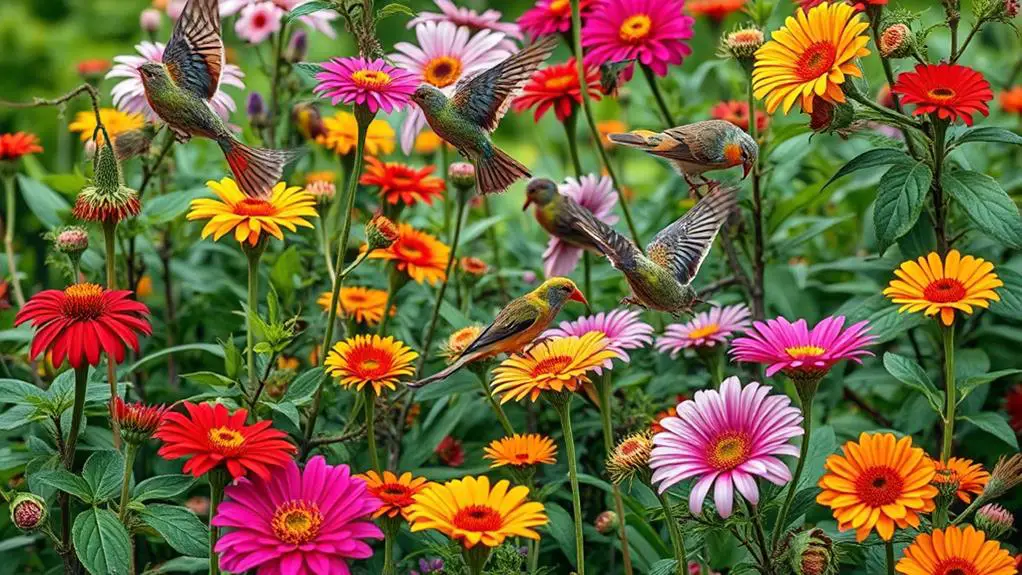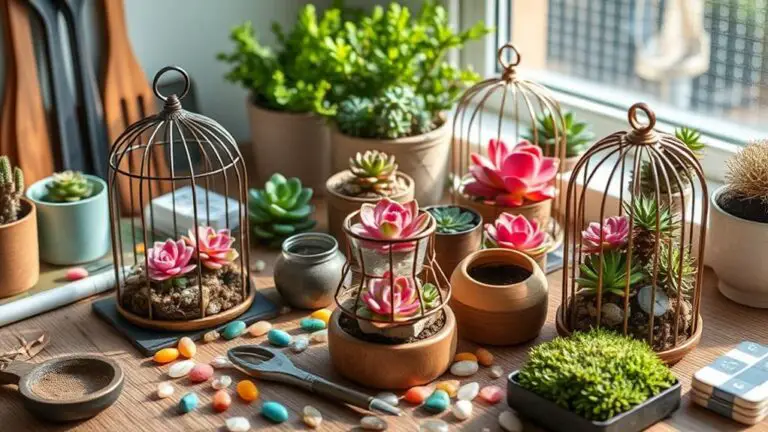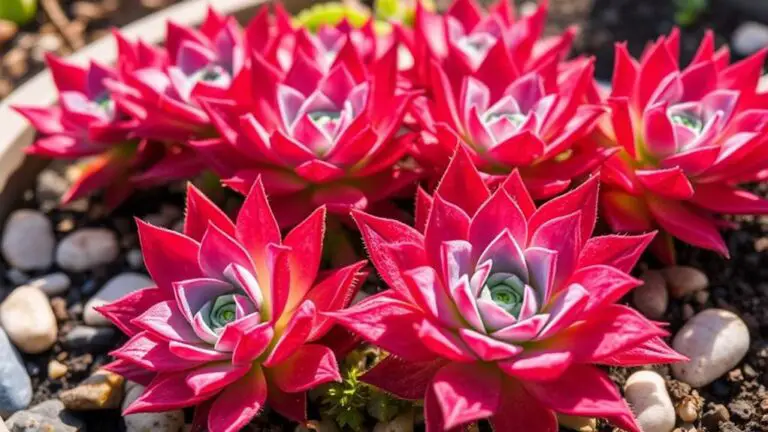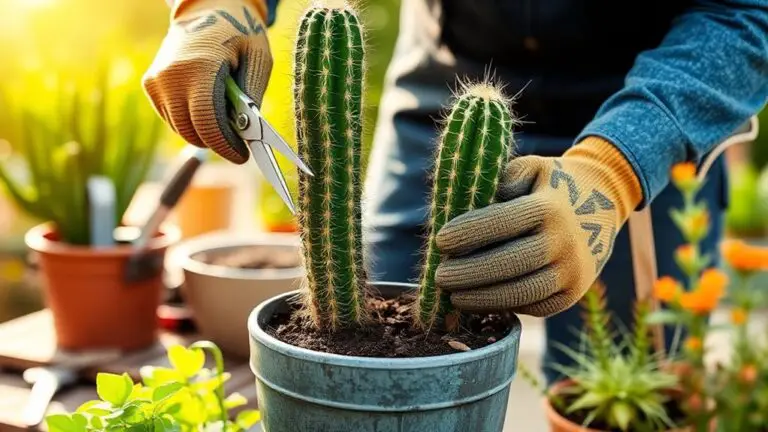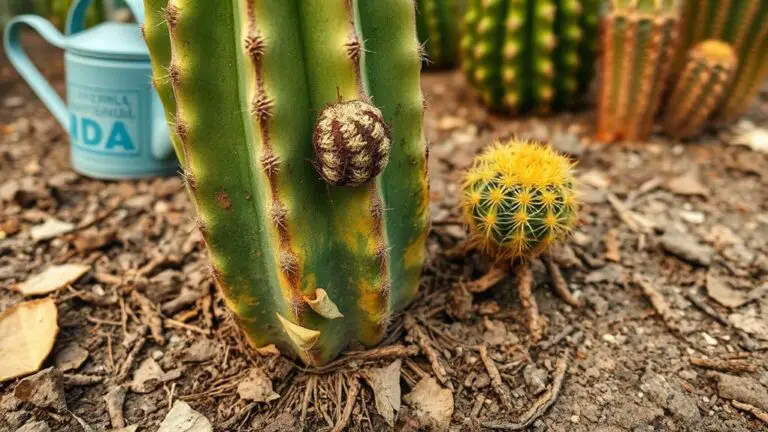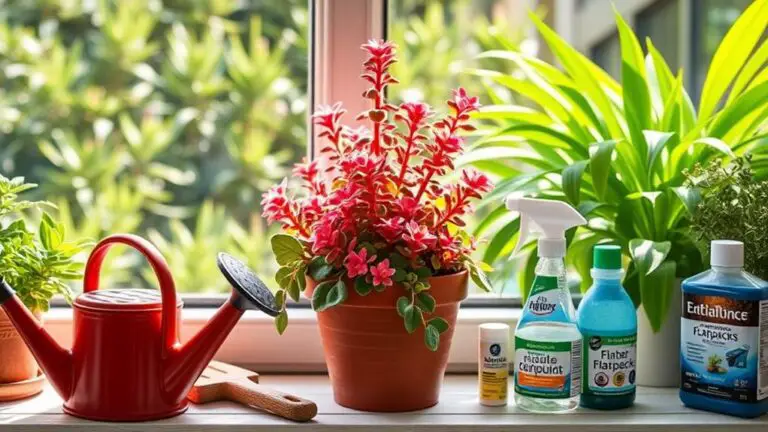Top 10 Flowering Plants Every Birdwatcher Should Grow
If you're passionate about birdwatching and want to transform your garden into a haven for feathered friends, choosing the right flowering plants can make all the difference. Imagine vibrant sunflowers towering above, attracting seed-eating birds, while coneflowers and black-eyed Susans create a colorful, inviting landscape. These plants don't just beautify your space; they support local wildlife and enhance biodiversity. Intrigued by how these flora can elevate your birdwatching experience? Let's explore the top ten choices that will turn your garden into a bustling avian sanctuary.
Sunflower (Helianthus Spp.)
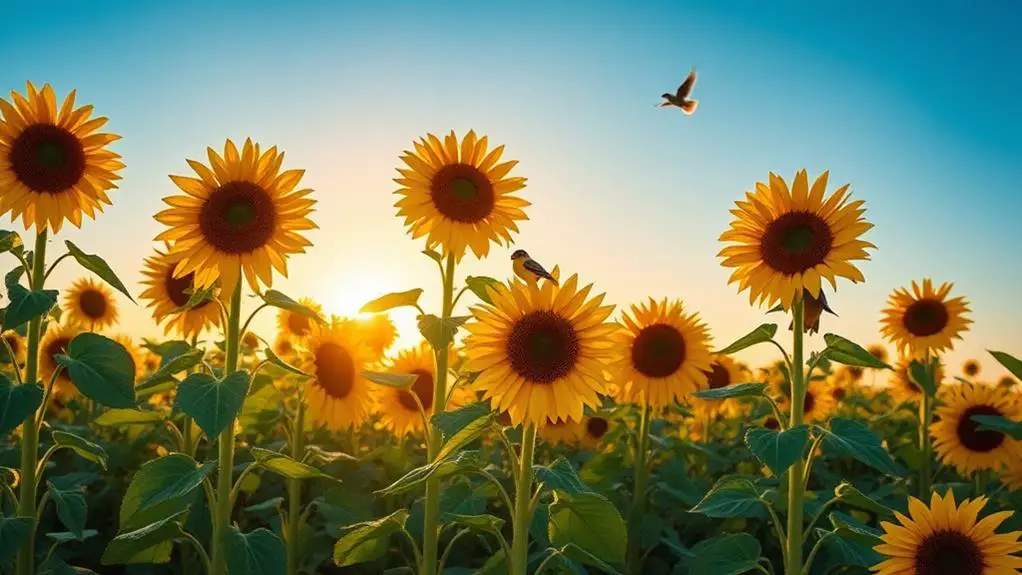
When it comes to attracting birds to your garden, sunflowers (Helianthus spp.) are a top choice. These easy-to-grow annuals thrive in full sun and can reach impressive heights, from 2 to 15 feet, depending on the cultivar. Their large, open flower heads produce an abundance of seeds that seed-eating birds, like finches, chickadees, and nuthatches, love. The seeds are a favorite and provide a natural food source that attracts birds to your garden.
Sunflowers are also drought-tolerant once established, making them a resilient option for various soil types. This adaptability means you don't need to worry too much about perfect conditions. Just plant them in a sunny spot, and they'll flourish.
Leaving the flower heads intact after blooming is a great way to continue supporting wildlife. During autumn and winter, these seeds will help sustain birds when other food sources are scarce.
Plus, with their vibrant yellow and orange blooms, sunflowers not only attract birds but also brighten up your garden.
Coneflower (Echinacea Spp.)
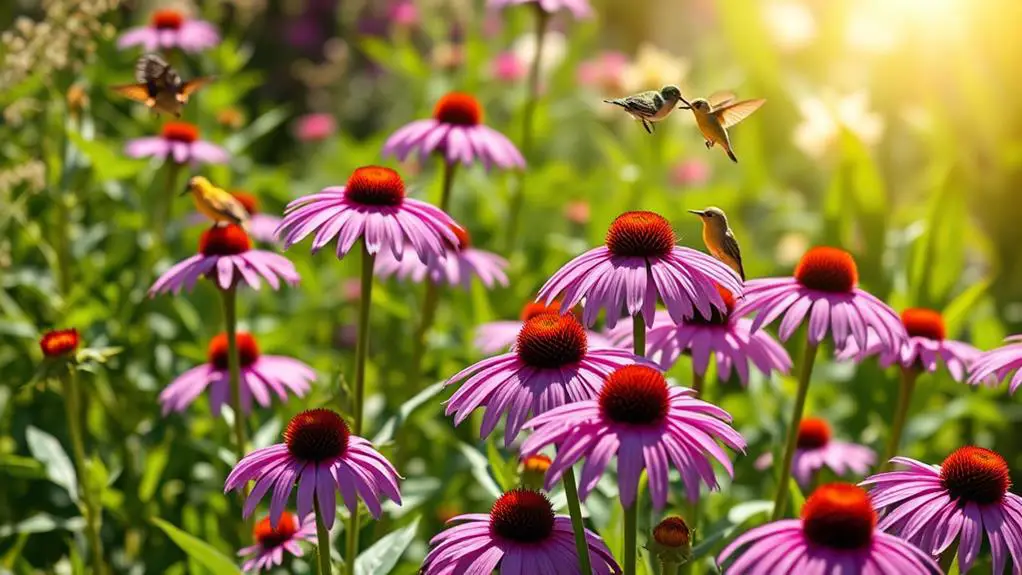
Coneflower (Echinacea spp.) is a fantastic addition to your garden if you want to attract birds and pollinators.
Its vibrant flowers bloom from mid-summer to fall, providing nectar for butterflies and bees, while the seed heads offer food for goldfinches and other birds.
Plus, it's easy to grow in full sun and well-drained soil, ensuring your garden thrives with minimal effort.
Attracts Birds and Pollinators
One of the top choices for birdwatchers and garden enthusiasts alike, coneflowers (Echinacea spp.) offer more than just visual appeal.
These hardy perennials attract hummingbirds and other bird species with their vibrant blooms. The flowers' nectar is a rich food source for hummingbirds, while the large, cone-shaped centers provide food for many other birds. You'll find that coneflowers attract a variety of pollinators, including bees and butterflies, throughout the summer months.
Planting coneflowers in your garden means you're not just adding beauty but also supporting local wildlife.
These plants thrive in sunny locations and adapt well to different soil types, making them easy to grow. Plus, they're low-maintenance, so you won't have to spend much time caring for them. They can even self-seed, ensuring they'll return year after year to keep attracting birds and pollinators.
Provides Winter Seeds
The large, cone-shaped seed heads of Echinacea spp. are a winter lifeline for many birds, especially goldfinches. When you grow Coneflower (Echinacea) in your garden, you're not just adding beauty; you're providing crucial winter seeds that serve as food for birds.
These sturdy perennials bloom from late spring to early autumn, ensuring a continuous supply of seeds as the seasons change. To maximize the benefits for your feathered friends, leave the seed heads intact after blooming. This simple act supports local bird populations and enhances the aesthetic appeal of your garden.
Here are three key reasons to include Coneflowers in your bird-friendly garden:
- Food for Birds: The seeds provide a crucial food source during the colder months when other food options are limited.
- Hardy and Adaptable: Echinacea thrives in various soil types and conditions, making it an easy addition to any garden.
- Ecosystem Balance: Beyond feeding birds, Coneflowers attract pollinators, contributing to a well-rounded, healthy garden ecosystem.
Cornflower (Centaurea Cyanus)

Among the many enchanting flowers you can choose for your garden, Cornflower (Centaurea Cyanus) stands out with its vibrant blue, blue-purple, and pink blooms that grace your garden from May to July. This hardy annual is not only a feast for the eyes but also a boon for birdwatchers. Cornflowers produce seeds that birds eat, especially in late summer and fall when food is scarce. By planting cornflowers, you're providing a reliable food source for your feathered friends.
Cornflowers are easy to grow, even for novice gardeners. They thrive in lean soil conditions and are drought-resistant, meaning they don't need much pampering. Plus, they are self-seeding, so once you plant them, they'll likely return year after year with minimal effort on your part.
Additionally, cornflowers attract insects like bees and butterflies, enhancing the biodiversity of your garden. This not only benefits the ecosystem but also creates a more vibrant and lively garden space for you to enjoy.
| Feature | Benefit | Season |
|---|---|---|
| Vibrant Blooms | Eye-catching colors | May to July |
| Seed Production | Birds eat seeds | Late summer to fall |
| Self-seeding | Returns yearly | Ongoing |
| Insect Attraction | Enhances biodiversity | Spring to summer |
Black-Eyed Susan (Rudbeckia Hirta)
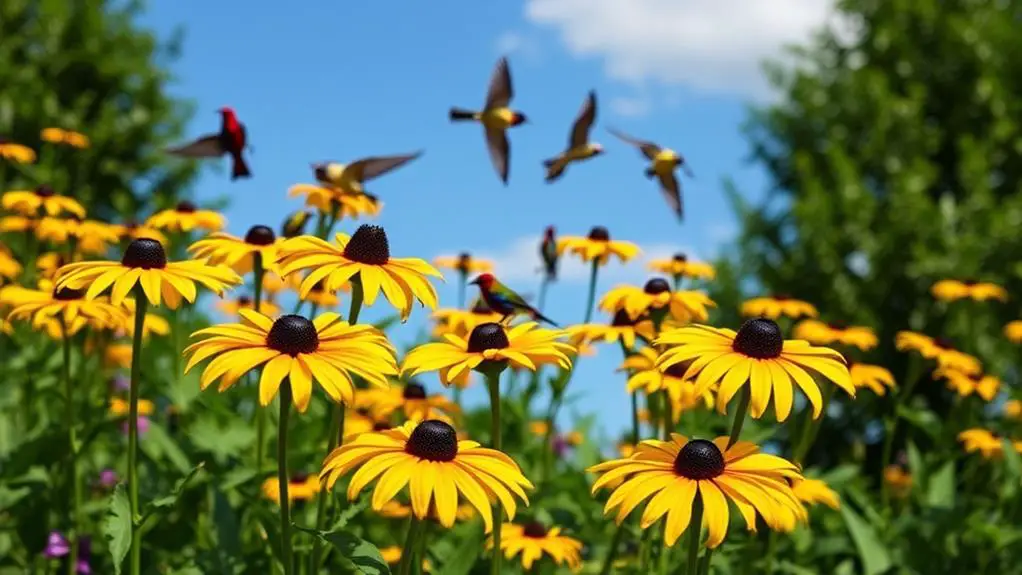
While cornflowers bring a splash of vibrant color and a feast for birds during the summer, Black-Eyed Susan (Rudbeckia hirta) extends the visual and ecological benefits into late summer and fall.
This native North American wildflower showcases bright yellow petals with dark brown centers, making it a standout in any garden. It's not just about looks; these flowers are a magnet for pollinators and birds alike.
You'll love how Black-Eyed Susan provides essential food for birds, especially finches and chickadees, through its seed-filled cones.
It's a hardy perennial that thrives in various soil types, so you won't have to worry about fussy planting conditions. Plus, it can self-seed, ensuring your garden remains a haven for wildlife year after year.
Here are three reasons to contemplate growing Black-Eyed Susan:
- Attract Birds: The flower's seeds are a favorite among many bird species.
- Easy to Grow: It adapts to different soils and conditions, requiring minimal maintenance.
- Sustained Blooming: Enjoy beautiful blooms from mid-summer into the fall.
Planting Black-Eyed Susan is a simple yet effective way to enrich your garden while supporting local bird populations.
Daisy (Bellis Perennis)
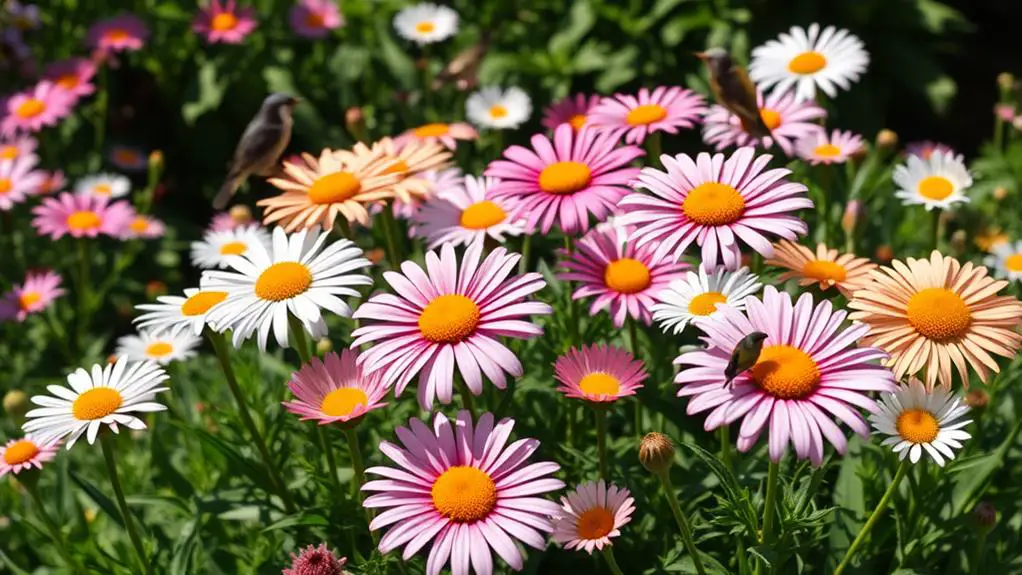
Daisy's cheerful white petals and bright yellow centers are sure to catch your eye and the attention of various bird species. These perennial flowers are a favorite among finches and sparrows, who love to feast on their nutritious seeds.
Adding Daisies to your garden not only enhances its beauty but also invites a variety of birds to visit.
Daisies thrive best in well-drained soil and full sun, making them an easy addition to your garden. They typically bloom from spring to early summer, creating a lovely display that's hard to miss.
These versatile plants can grow up to 12 inches tall, making them perfect for flower beds and garden borders.
One of the fantastic things about Daisies is their ability to self-seed. This means they can spread naturally and continue providing food sources for birds year after year without much effort from you.
Besides attracting birds, Daisies also support pollinators like bees and butterflies, contributing to a healthy garden ecosystem.
Aster (Symphyotrichum Spp.)
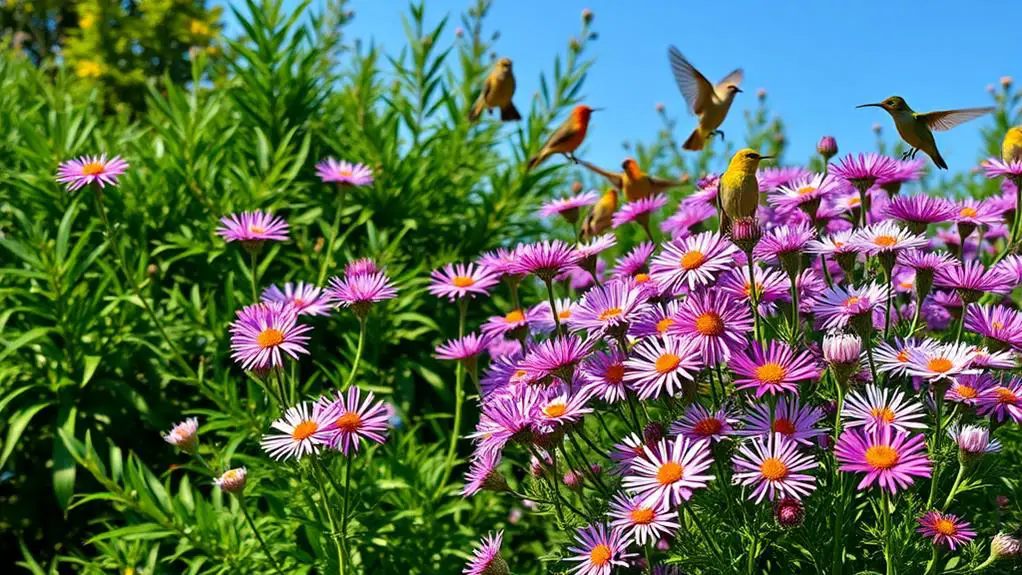
Asters (Symphyotrichum spp.) are perfect for your garden if you want to support birds and pollinators, especially in the fall.
These tall, vibrant flowers offer essential nectar and seeds when other food sources are dwindling.
Plant them in sunny spots with well-drained soil, and you'll see a variety of birds and insects visiting your garden.
Late-Season Food Source
If you're looking to support birds as they gear up for migration, consider planting asters, particularly the New England aster (Symphyotrichum novae-angliae), in your garden.
These beautiful flowers bloom in late summer to fall, providing an essential late-season feeding source for hungry birds. As temperatures drop, the seeds produced by asters become a significant food supply for many bird species, including goldfinches.
Asters thrive in full sun and well-drained soil, making them easy to grow even in poor soil conditions. Their flowers attract a variety of pollinators, which helps maintain a healthy ecosystem in your garden.
Here's why you should add asters to your garden:
- Late-season feeding: Asters bloom when many other plants have finished flowering, ensuring birds have food as they prepare for migration.
- Flowers attract birds: The seeds are a favorite for birds like goldfinches, providing them with necessary nutrition during colder months.
- Easy to grow: Asters can handle poor soil and require little maintenance, making them a perfect choice for any garden.
Attracts Pollinators and Birds
While providing a late-season food source is essential, it's equally important to contemplate how your garden can attract both pollinators and birds throughout the year. Planting asters (Symphyotrichum spp.) is a fantastic way to achieve this. These flowers bloom in colors like white, pink, blue, and purple, making your garden visually appealing and lively with activity.
Asters are perennial plants that produce abundant seeds, serving as a significant food source for birds, especially in the fall when other options are scarce. This makes them a reliable choice for year-round birdwatching.
Additionally, the nectar-rich flowers attract important pollinators, including butterflies and bees. These pollinators aren't only beautiful to watch but also support the overall health of your garden.
Being adaptable, asters can thrive in various soil conditions, making them a versatile addition to your garden. They're perfect for enhancing local biodiversity and supporting native trees.
By incorporating asters, you contribute to ecological balance, offering food for birds and creating a diverse habitat for various wildlife species.
In short, growing asters helps you create a thriving, bird-friendly garden that supports pollinators and provides a consistent food source.
Marigold (Tagetes Spp.)
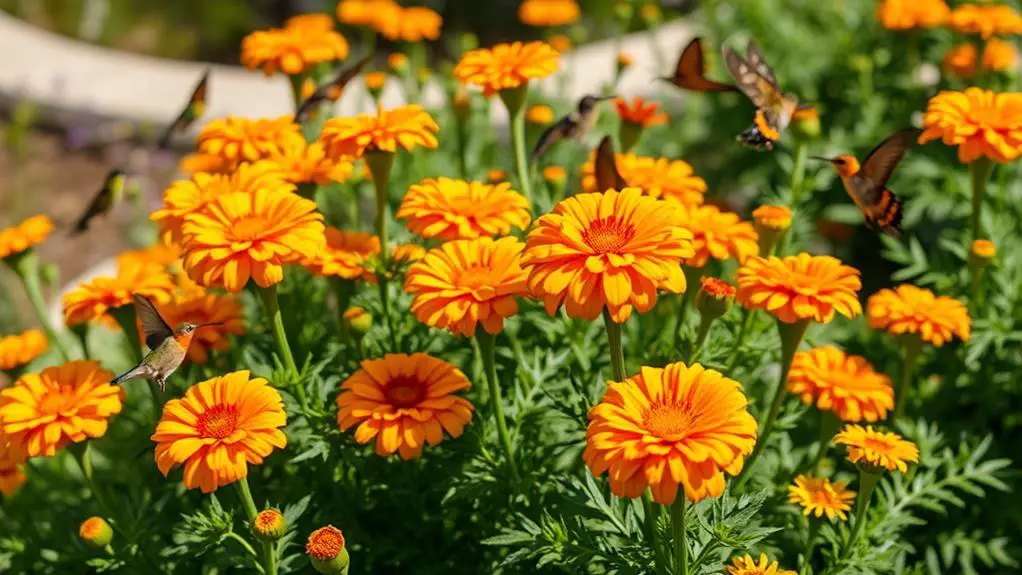
Marigolds (Tagetes spp.) are a fantastic choice for birdwatchers looking to enhance their garden's appeal. These vibrant flowers bloom in shades of yellow, orange, and cream, creating a dazzling display that attracts birds.
Marigolds aren't only beautiful but also easy to grow, thriving in various conditions. Whether you're a seasoned gardener or just starting out, you'll find marigolds to be a rewarding addition.
One of the best things about marigolds is their ability to self-seed. After the flowers bloom, leave the flower heads intact. This allows them to produce seeds, which serve as a nutritious food source for birds like finches and sparrows during fall and winter.
Additionally, marigold seeds are rich in nutrients, making them a favorite among many bird species.
Here are three reasons why you should consider planting marigolds:
- Easy to Grow: Marigolds thrive in various conditions, making them perfect for gardeners of all skill levels.
- Bird-Friendly: Their seeds provide birds with a valuable food source during colder months.
- Pest-Repellent: Marigolds naturally repel pests, promoting a healthier garden environment.
Adding marigolds to your garden not only enhances its beauty but also supports local bird populations.
Virginia Creeper (Parthenocissus Quinquefolia)
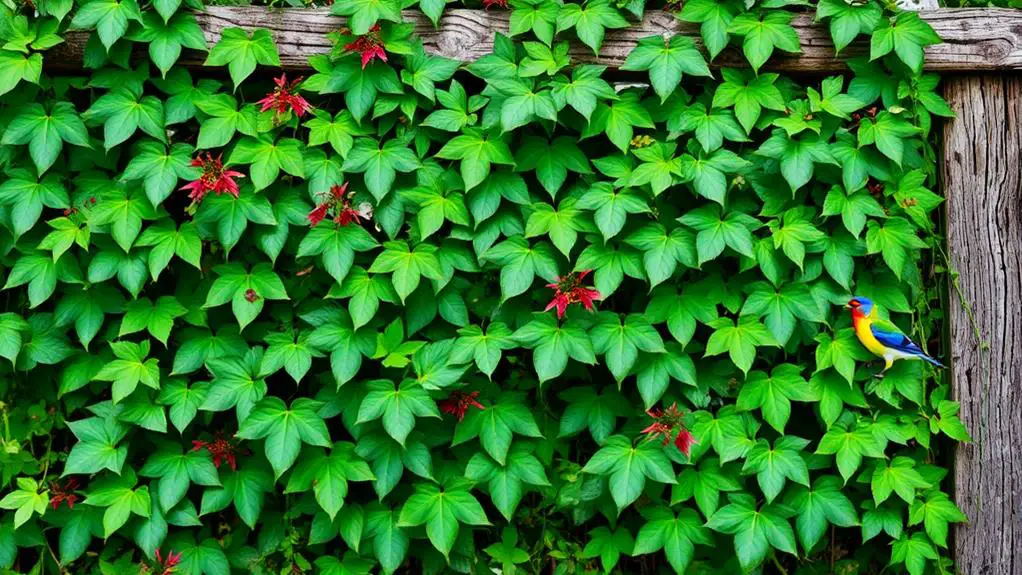
Virginia Creeper (Parthenocissus quinquefolia) bursts into action as a fast-growing vine, capable of reaching an impressive 50 feet. It's perfect for covering fences, trellises, and walls, creating a lush, green backdrop in your garden. One of the great benefits of growing Virginia creeper is how it supports birdwatching. This plant produces small blue-black berries in the fall, which many birds, such as mockingbirds and blue jays, love to eat. These berries provide a crucial food source during the colder months when food is scarce.
Additionally, the dense foliage of Virginia creeper offers excellent shelter and nesting sites, enhancing habitat diversity in your garden. You'll be able to attract various birds, giving them a safe place to rest and raise their young. It's a hardy plant that thrives in different soil types and light conditions, so you won't have to worry too much about where you plant it. Plus, its vibrant red foliage in autumn adds a beautiful splash of color to your garden, making it visually appealing while supporting local ecosystems and wildlife.
| Feature | Benefit |
|---|---|
| Fast-growing vine | Covers large areas quickly |
| Blue-black berries | Food source for birds |
| Dense foliage | Shelter and nesting sites |
| Hardy plant | Easy to grow and maintain |
Elderberry (Sambucus Canadensis)
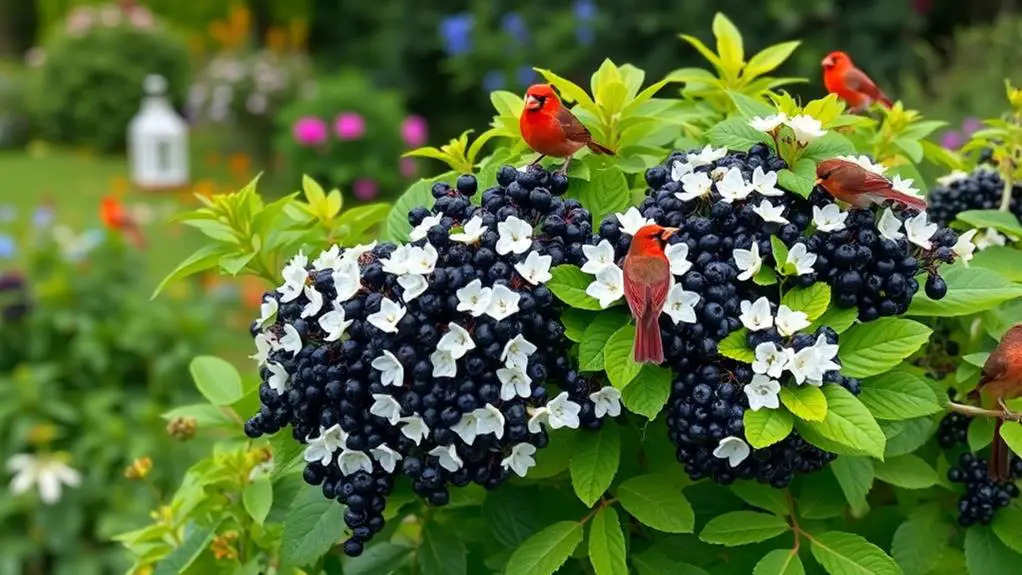
Elderberry (Sambucus canadensis) is a great choice if you want to attract a variety of birds to your garden.
Its dark blue berries are a favorite snack for thrushes and blue jays in late summer and fall, while the shrub itself offers excellent habitat and shelter.
Plus, its flowers will bring in pollinators like bees and butterflies, boosting your garden's biodiversity.
Bird-Friendly Edible Berries
A harmonious garden often features bird-friendly edible berries like those produced by the elderberry shrub (Sambucus canadensis). These dark blue to black berries appear in late summer and fall, becoming a favorite of birds such as thrushes and cardinals. Not only are elderberries a nutritious treat for your feathered friends, but they also add beauty and biodiversity to your garden.
Here are three reasons why you should consider adding elderberry shrubs to your garden:
- Bird-Friendly Edible Berries: The elderberry's clusters of berries are rich in antioxidants, providing an essential food source for birds. They help sustain local wildlife populations, particularly during the late summer and fall when other food sources might be scarce.
- Versatile Growth: Elderberry shrubs can grow up to 12 feet tall and adapt to various soil types. This versatility makes them an excellent choice for different garden settings, whether you're working with sandy, loamy, or clay soil.
- Human Benefits: Besides supporting birds, elderberries are valuable for humans too. You can use them to make jams, jellies, and herbal remedies, promoting a sustainable approach to gardening.
Habitat and Shelter Provider
When you're looking to create a bird-friendly garden, don't overlook the importance of providing habitat and shelter. Elderberry (Sambucus canadensis) is an excellent choice for this purpose. This versatile shrub not only produces dark blue fruit that birds love, but it also creates a dense habitat perfect for shelter and nesting.
Elderberry's thick foliage offers birds a safe haven from predators and harsh weather. Its branches provide excellent spots for nest building, making it a key habitat and shelter provider.
In addition to its protective qualities, Elderberry blooms attract many pollinators with its beautiful white flowers in the spring. These flowers enhance the ecosystem, supporting insects that birds feed on.
The berries ripen from late summer to fall, providing an essential food source when other options might be scarce. This makes Elderberry an essential addition to your bird-friendly garden.
Plus, it's easy to grow and adapts well to various soil types, making it a practical choice for gardeners at any skill level.
Attracts Diverse Bird Species**
Not only does Elderberry provide excellent habitat and shelter, but it also attracts a wide range of bird species, making it a must-have for any birdwatcher's garden. The dark blue berries produced by Elderberry (Sambucus canadensis) are a favorite among thrushes, robins, and blue jays, offering a crucial food source during late summer and fall. This means your garden will be buzzing with bird activity during these seasons.
To understand why Elderberry is essential for bird-friendly gardens, consider these points:
- Food Source: The dark blue berries aren't just nutritious but also plentiful, ensuring that various bird species flock to your garden.
- Pollinator Attraction: The attractive white flowers that bloom in late spring draw in numerous pollinators. This boosts your garden's ecosystem, indirectly benefiting the birds.
- Nesting Sites: The dense foliage offers excellent nesting sites and shelter, providing a safe haven for birds to raise their young.
Elderberry plants thrive in different soil conditions and require minimal maintenance, making them an ideal choice if you want to attract diverse bird species.
Staghorn Sumac (Rhus Typhina)

Why not enhance your garden with the stunning and versatile Staghorn Sumac (Rhus typhina)? This wildlife-friendly plant produces vibrant red, fuzzy fruit clusters in late summer and autumn. These fruits are an essential winter food source for birds like robins, thrushes, and cardinals. You'll love how this plant invites these feathered friends into your yard.
Staghorn sumac isn't just for the birds; it also adds a unique visual interest. Its velvety stems, which resemble stag antlers, make it a standout in any garden. This deciduous shrub can grow up to 15 feet tall and 20 feet wide, creating a perfect habitat for various wildlife.
One of the best features of staghorn sumac is its hardiness. It thrives in many soil types, including poor and sandy soils, and is highly drought-tolerant once established. This makes it a low-maintenance choice for any bird-friendly garden.
Moreover, staghorn sumac attracts beneficial insects and pollinators with its small yellow-green flowers that bloom in summer. This contributes to a diverse and vibrant ecosystem in your garden.
Frequently Asked Questions
What Flower Attracts Birds the Most?
Sunflowers attract birds the most due to their highly nutritious seeds. You'll find finches, nuthatches, and other seed-eating birds flocking to them, especially in autumn. Planting sunflowers can create a lively birdwatching experience in your garden.
What Is the Most Successful Flowering Plant?
Sunflowers are the most successful flowering plant for attracting birds. You'll see a variety of species flock to their large, nutrient-rich seeds, making them a must-have if you want to draw in seed-eating birds.
What Is the Best Plant to Feed Birds?
You should grow sunflowers to feed birds. Their large seed heads provide high nutritional value, attracting species like goldfinches and nuthatches. You'll love watching these birds flock to your garden for a reliable food source.
What Is the #1 Thing Plants Need to Grow?
The #1 thing plants need to grow is sunlight. You can't overlook it because it's essential for photosynthesis. Make certain your plants get at least 6 to 8 hours of direct sunlight daily for ideal growth and blooming.
Conclusion
You've got this! By planting these top 10 flowering plants, you're not only creating a beautiful garden but also supporting local birds and wildlife. Each plant is easy to grow and maintain, making your gardening journey enjoyable and rewarding. Just imagine the colorful blooms and happy birds visiting your garden. So go ahead, get your hands dirty, and watch your garden transform into a lively haven for all kinds of feathered friends. Happy gardening!

